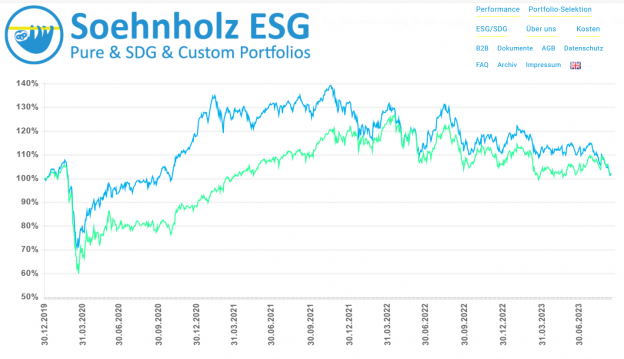Responsible derivatives: 10x new research on migration, ESG labels, biodiversity measurement, effective shareholder voting, responsible investing mandates, green derivatives, structured products, stock market models, IPOs and alternative investments (# shows the number of full paper SSRN downloads as of Nov. 2nd, 2023)
Social and ecological research (responsible derivatives)
Migration policy backlash: The Effect of Foreign Aid on Migration: Global Micro Evidence from World Bank Projects by Andreas Fuchs, Andre Groeger, Tobias Heidland and Lukas Wellner as of Oct. 2023: “Our short-term results indicate that the mere announcement of a World Bank aid project significantly decreases migration preferences. We find similar effects for project disbursements, which also reduce asylum seeker flows to the OECD in the short run. This reduction seems related to enhanced optimism about the economic prospects in aid recipient provinces and improved confidence in national institutions. In the longer run, aid projects increase incomes and alleviate poverty. The negative effect of aid on asylum seeker flows fades out, and regular migration increases. … There is no evidence in our study that targeting the “root causes” of migration through aid on average increases irregular migration or asylum seeker numbers. … In the short run, aid projects reduce migration preferences and asylum seeker flows to the OECD from Latin America, MENA, and non-fragile Sub-Saharan African countries. However, we do not find a significant effect in fragile countries of Sub-Saharan Africa, which are an important source of irregular migration to Europe. For policymakers, a key takeaway from our study is that aid projects do not keep people from migrating from the 37 most hostile environments, but they can be effective in more stable environments” (p. 37/38).
Sustainable investing research (responsible derivatives)
Rating beats label: Talk vs. Walk: Lessons from Silent Sustainable Investing of Mutual Funds by Dimitrios Gounopoulos, Haoran Wu, and Binru Zhao as of Oct. 26th, 2023 (#81): “… in the Morningstar fund sustainability rating landscape, most funds with top ratings do not self-label as ESG funds (“silent” sustainable investing). … We find that investors tend to overemphasize ESG labels and often overlook sustainability rating signals in the market. More importantly, we show that “silent” funds with high sustainability ratings have comparable return performance to ESG funds and that high sustainability ratings have a stronger influence on mitigating fund risks than the ESG label” (p. 33/34). My comment: In general, I agree. But the type of ESG rating used is also very important. Watch out for my next opinion blogpost on Apple, Amazon, Alphabet etc. and their ESG-ratings
Biodiversity confusion: Critical review of methods and models for biodiversity impact assessment and their applicability in the LCA context by Mattia Damiani, Taija Sinkko, Carla Caldeira, Davide Tosches, Marine Robuchon, and Serenella Sala as of Nov. 17th, 2022 (#139): “… The five main direct drivers of biodiversity loss are climate change, pollution, land and water use, overexploitation of resources and the spread of invasive species. … this article aims to critically analyse all methods for biodiversity impact assessment … 54 methods were reviewed and 18 were selected for a detailed analysis … There is currently no method that takes into account all five main drivers of biodiversity loss” (abstract).
Explain to change: Voting Rationales by Roni Michaely, Silvina Rubio, and Irene Yi as of Aug. 16th, 2023 (#279): “…studying voting rationales of institutional investors from across the world, for votes cast in US companies’ annual shareholder meetings between July 2013 and June 2021. … institutional investors vote against directors mainly because of (lack of) independence and board diversity. We also find evidence of some well-known reasons for opposing directors, such as tenure, busyness, or firm governance. Institutional investors are increasingly voting against directors due to concerns over environmental and social issues. Our results indicate that voting rationales are unlikely to capture proxy advisors’ rationales, but rather, the independent assessment of institutional investors. … We find that companies that receive a higher proportion of voting rationales related to board diversity (or alternatively, excessive tenure or busy directors) increase the fraction of females on board in the following year (reduce average tenure or director busyness), and the results are driven by companies that receive high shareholder dissent. … our results suggest that disclosure of voting rationales is an effective, low-cost strategy that institutional investors can use to improve corporate governance in their portfolio companies“ (p. 31/32).
Impact impact? Evaluating the Impact of Portfolio Mandates by Jack Favilukis, Lorenzo Garlappi, and Raman Uppal as of Oct. 2nd, 2023 (#56): “… we examine the impact of portfolio (Sö: e.g. ESG or impact investing) mandates on the allocation of physical capital in a general-equilibrium economy with production and heterogenous investors. … we find that the effect of portfolio mandates on the allocation of physical capital across sectors can be substantial. In contrast, the impact on the equilibrium cost of capital and Sharpe ratio of firms in the two sectors remains negligible, consistent with existing evidence. Thus, a key takeaway of our analysis is that judging the effectiveness of portfolio mandates by studying their effect on the cost of capital of affected firms can be misleading: small differences in the cost of capital across sectors can be associated with significant differences in the allocation of physical capital across these sectors” (p. 31/32). My comment: With my ESG and SDG investing mandates I want to invest as responsibly as possible and hope to achieve similar performances as less responsible investments. With this approach, there is no need to try to prove lower cost of capital for responsible companies.
Responsible derivatives? Climate Risk and Financial Markets: The Case of Green Derivatives by Paolo Saguato as of Oct. 30th, 2023 (#37): “The post-2008 derivatives markets are more transparent and more collateralized than before. However, this regulatory framework might impose excessive regulatory and compliance costs to derivatives market which would undermine market incentives and hamper financial innovation in the green derivatives. … Right now, bespoke OTC sustainable derivatives are the predominant structures in the market, but as soon as green assets and sustainability benchmark standardization will become the norm, then exchange-traded green derivatives might start to develop more strongly, providing a valuable and reliable support to a green transition” (p. 23).
Other investment research
Responsible derivatives? Structured retail products: risk-sharing or risk-creation? by Otavio Bitu, Bruno Giovannetti, and Bernardo Guimaraes as of October 31, 2023 (#151): “Financial institutions have been issuing more complex structured retail products (SRPs) over time. Is risk-sharing the force behind this financial innovation? Is this innovation welfare-increasing? We propose a simple test for that. If a given type of SRP is not based on risk-sharing and pours new unbacked risk into the financial system, we should observe an unusual negative relation between risk and expected return offered to buyers across products of that type. We test this hypothesis using a sample of 1,847 SRPs and find that a relevant type of SRP (Autocallables) creates new unbacked risk” (abstract).
Irrational finance professional? Mental Models of the Stock Market by Peter Andre, Philipp Schirmer, and Johannes Wohlfart as of Oct. 31st, 2023 (#74): “Financial markets are governed by return expectations, which agents must form in light of their deeper understanding of these markets. Understanding agents’ mental models is thus critical to understanding how return expectations are formed. … We document a widespread tendency among households from the general population, retail investors, and financial professionals to draw inferences from stale news regarding future company earnings to a company’s prospective stock return, which is absent among academic experts. This striking difference in their return forecasts results from differences in agents’ understanding of financial markets. Experts’ reasoning aligns with standard asset pricing logic and a belief in efficient markets. By contrast, households and financial professionals appear to employ a naive model that directly associates higher future earnings with higher future returns, neglecting the offsetting effect of endogenous price adjustments. This non-equilibrium reasoning stems from a lack of familiarity with the concept of equilibrium rather than inattention to trading or price responses. … Our findings – that mental models differ across economic agents and that they drastically differ from standard economic theories among important groups of households and financial professionals who advise and trade for these households – are likely to have significant implications. For example, our findings can provide a new perspective on previously documented anomalies in return expectations and trading decisions” (p. 30/31).
M&A not IPO: IPOs on the decline: The role of globalization by M. Vahid Irani, Gerard Pinto, and Donghang Zhang as of Oct. 2nd, 2023 (#37): “Using the average percentage of foreign sales as a proxy for the level of globalization of the U.S. economy or a particular industry, we find that the decline in U.S. initial public offerings (IPOs), particularly small-firm IPOs, is significantly positively associated with the level of globalization at both the macroeconomy and the industry levels. We also find that increased globalization of an industry makes a U.S. private firm in the industry more likely to choose M&A sellouts over IPOs as an exit strategy”“ (abstract).
Unattractive Alternatives: Endowments in the Casino: Even the Whales Lose at the Alts Table by Richard M. Ennis as of Oct. 27th, 2023 (#516): “For more than two decades, so-called alternatives—hedge funds, private-market real estate, venture capital, leveraged buyouts, private energy, infrastructure, and private debt—have been the principal focus of institutional investors. Such investments now constitute an average of 60% of the assets of large endowments and 30% of public pension funds. … … endowments—across the board—have underperformed passive investment alternatives by economically wide margins since the GFC (Sö: Global Financial Crisis) … We observe that large endowments have recorded greater returns than smaller ones because they take greater risk (have a greater equity exposure), not as a result of their alt investing. In fact, their greater returns have occurred in spite of their heavier weighting of alt investments. Alt-investing has not been a source of diversification of stock market risk. … I estimate that institutional investors pay approximately 10 times as much for their alts as they do for traditional stock-bond strategies… despite exhibiting some skill with alts, large endowments would have been better off leaving them alone altogether” (p. 8/9). My comment: See Alternatives: Thematic replace alternative investments (prof-soehnholz.com)
……………………………………………………………………………………………………………………
Liquid impact advert for German investors
Sponsor my research by investing in and/or recommending my global small/midcap mutual fund (SFDR Art. 9). The fund focuses on social SDGs and uses separate E, S and G best-in-universe minimum ratings and broad shareholder engagement with currently 27 of 28 companies: FutureVest Equity Sustainable Development Goals R – DE000A2P37T6 – A2P37T or Noch eine Fondsboutique? – Responsible Investment Research Blog (prof-soehnholz.com)










